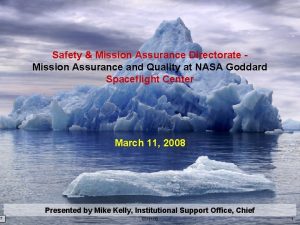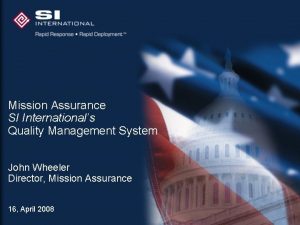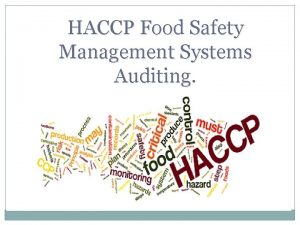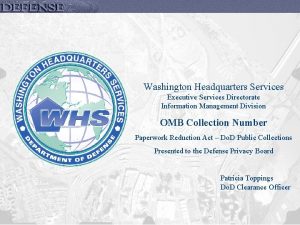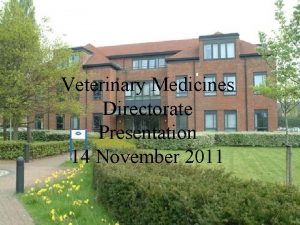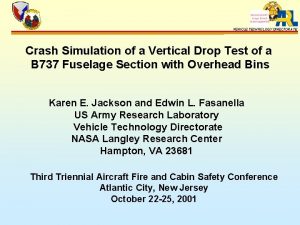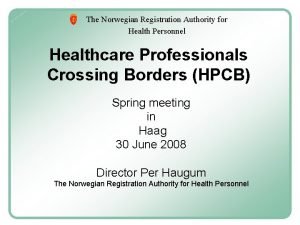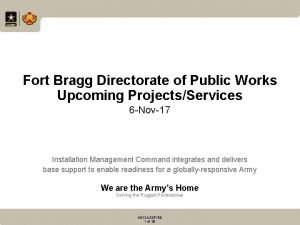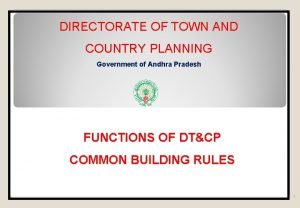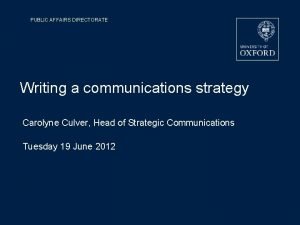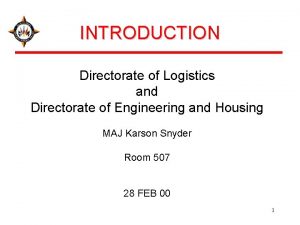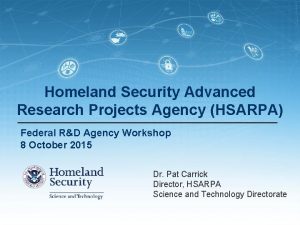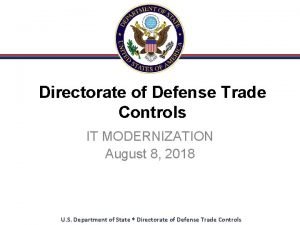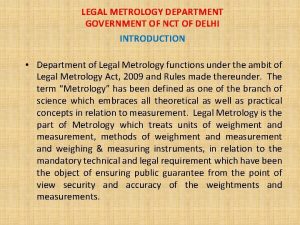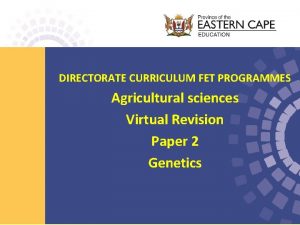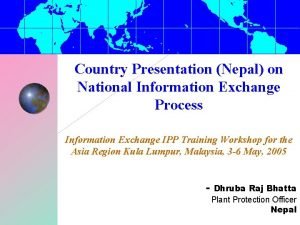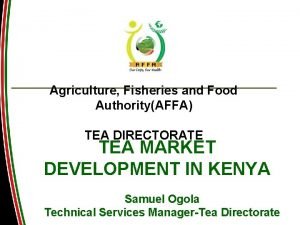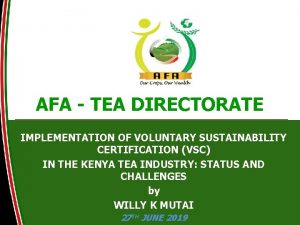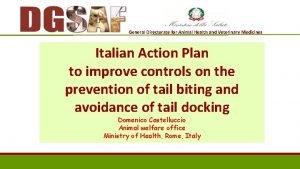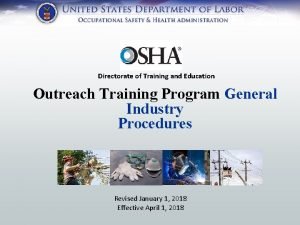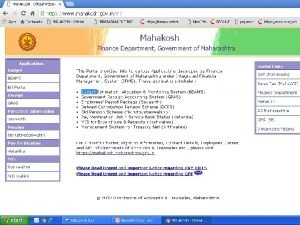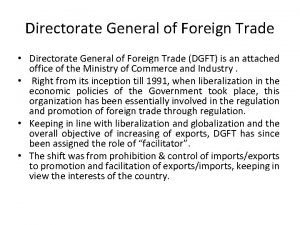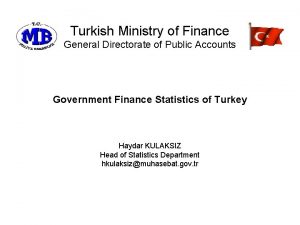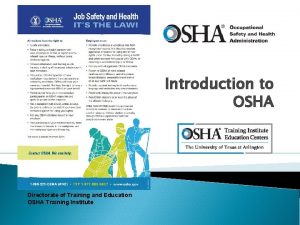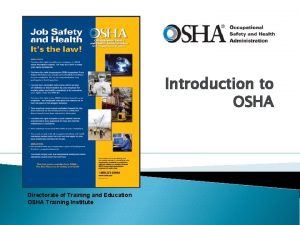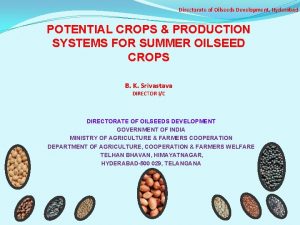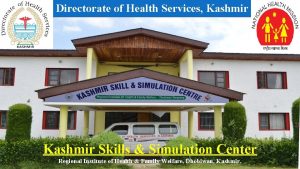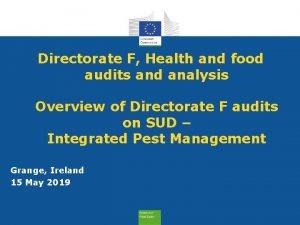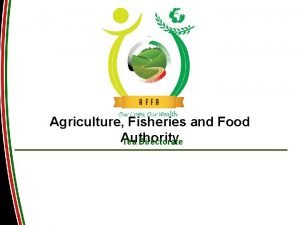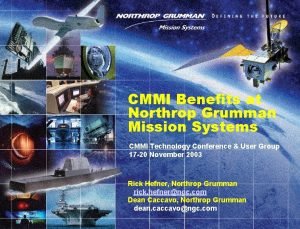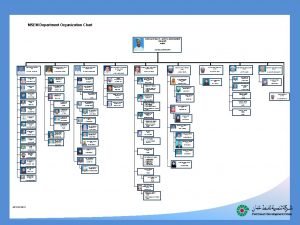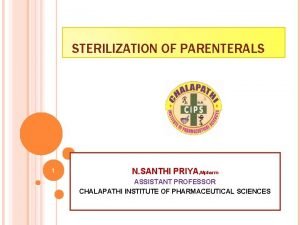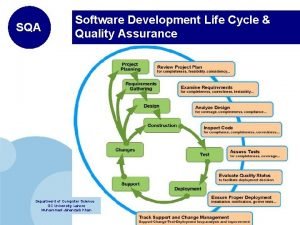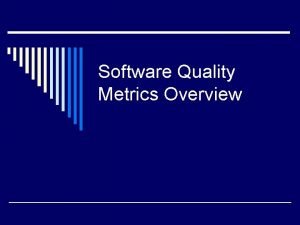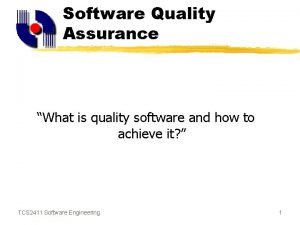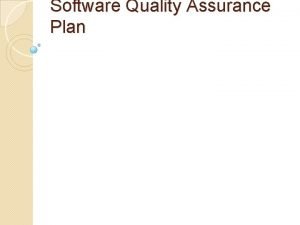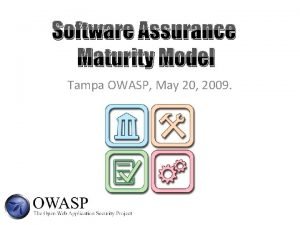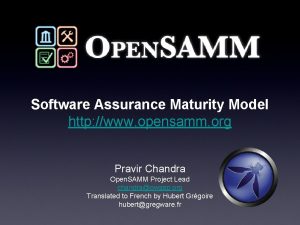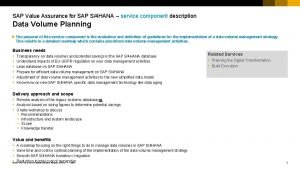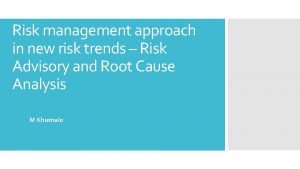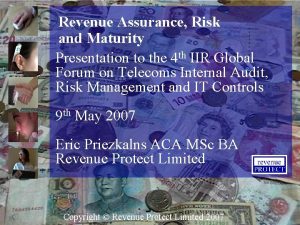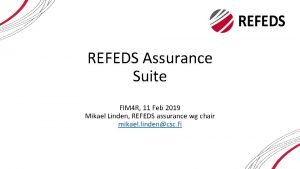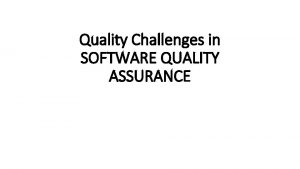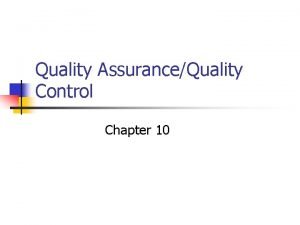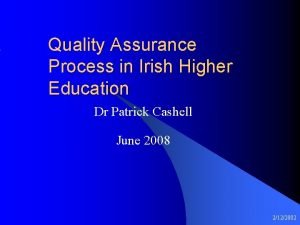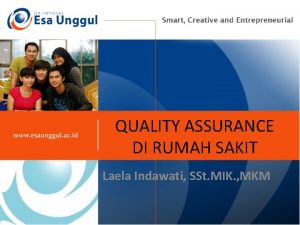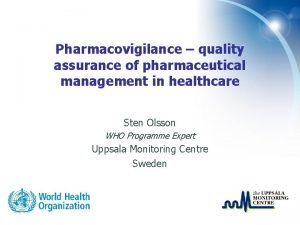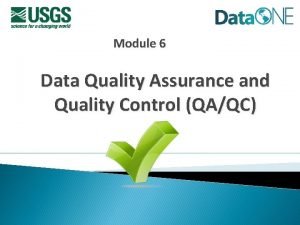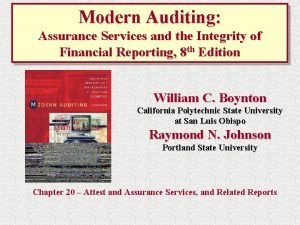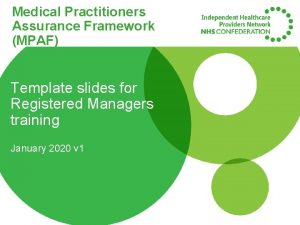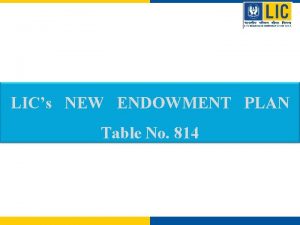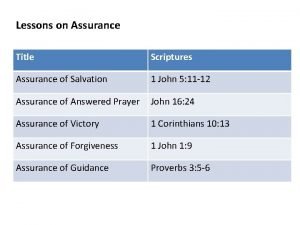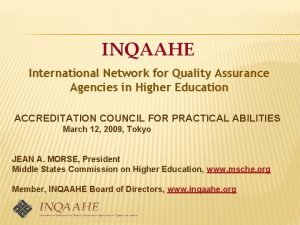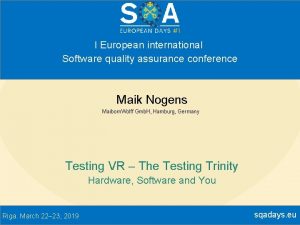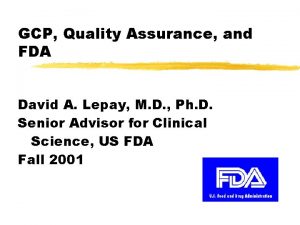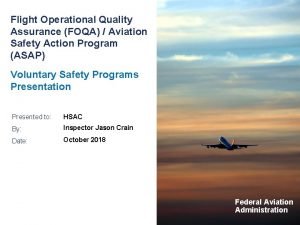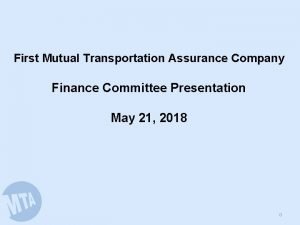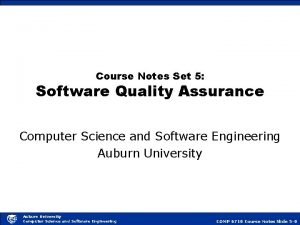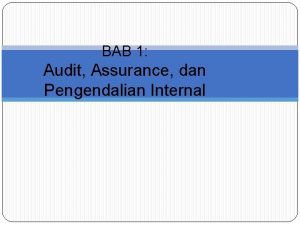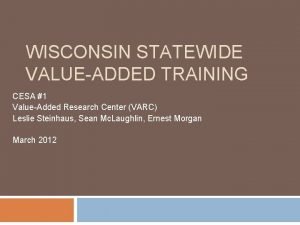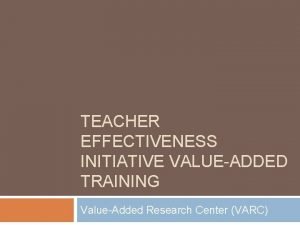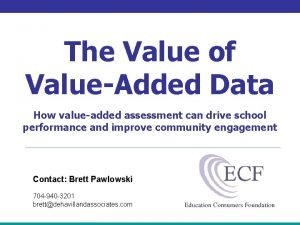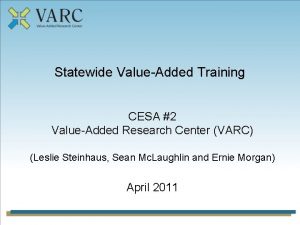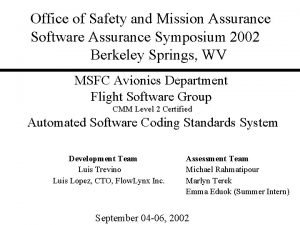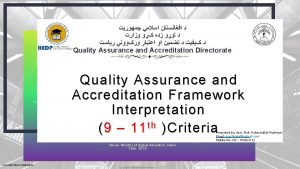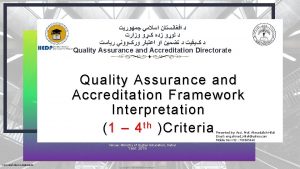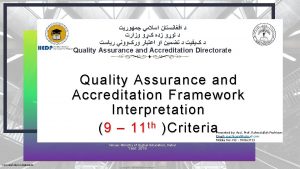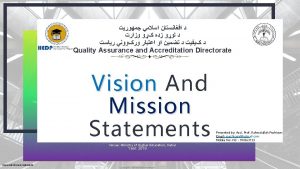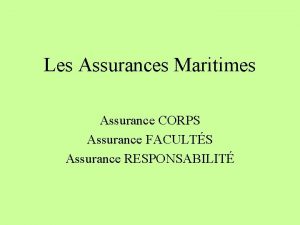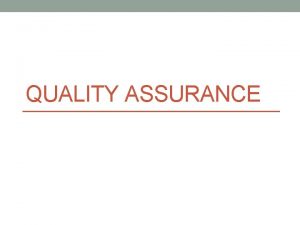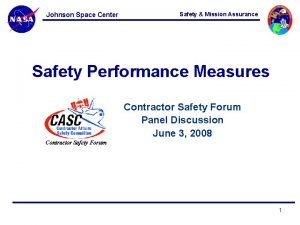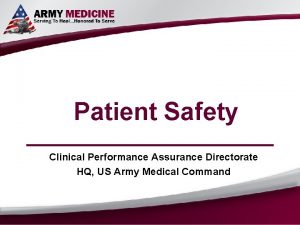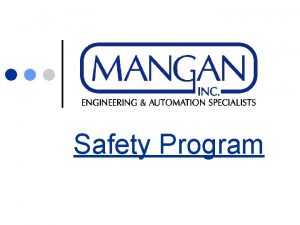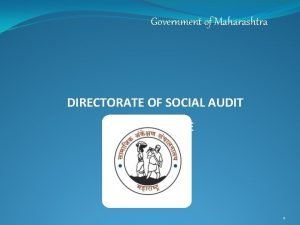NASAGSFC Safety Mission Assurance Directorate A ValueAdded Organization





























































































- Slides: 93

NASA/GSFC Safety & Mission Assurance Directorate A Value-Added Organization February 5, 2009 Presented by Mike Kelly, Institutional Support Office, Chief 8 February 3, 2009 1

AGENDA • Safety and Mission Assurance Directorate Organization Charts • How Code 300 Organization Interacts with a GSFC Projects – Code 323, Mission Assurance Branch – Code 324, Institutional Assurance Branch – NASA/GSFC Mission Assurance Approach – Standard MAR – Support at Suppliers – Software Assurance February 3, 2009 2

Agenda (Con’t) • Code 301, System Review Office • Code 302, Institutional Support Office – Supply Chain Management – Introduction to AS 9100 Class at GSFC – Lead Auditor Class at GSFC – Code 300 Orientation Program – Code 300 Education Series – GOLD Rules – Supplier Conference at GSFC – Internal Audit Training Program – Mission Operations Assurance February 3, 2009 3

Agenda (Con’t) • Code 300 EEE Parts/Workmanship Group – GIDEP Program – Workmanship Standards/Training – ESD Certification Program • Code 321, System Safety Branch – Safety Program – Typical Safety Deliverables • Code 322, Reliability and Risk Analysis Branch - Reliability and Risk Management Program – Typical Reliability Deliverables • Code 305, Resource Analysis Office • Presenter’s Lessons Learned February 3, 2009 4

GSFC Organization Chart * November 2008 Safety & Mission Assurance Directorate M. So * Safety & Mission Assurance Directorate, Deputy was added. February 3, 2009 5

Safety and Mission Assurance Directorate (Code 300) * (Draft, 02/02/09) (Vacant ) * Principal Engineer changed to “Vacant” February 3, 2009 6

Actual Manpower Numbers GSFC Greenbelt: 2957 civil servants GSFC: Greenbelt 5706 contractors supporting the civil servants (FY 05) GSFC Safety & Mission Assurance Directorate: 207 total distributed as follows: – 100 contractors – 107 civil servants • 87 permanent • 18 term • 2 co-op – Approximately 100 contractors total from Mantech/SRS and Honeywell February 3, 2009 7

Codes 323/324: Mission Assurance/Institutional Assurance Branches Name: Bob Savage/Rob Sticka Title: Branch Head Office W 120/W 126 D Tel: 68840/69900 Email: Robert. M. Savage@nasa. gov / Rob. Sticka@nasa. gov February 3, 2009 8

How Code 300 Organization Interacts With GSFC Projects PROGRAM MANAGER PROJECT MANAGER QUALITY ENGINEERING TEAM (HW/SW) RESIDENT OFFICE SUPPORT AT SUPPLIERS’ FACILITIES Code 320 SYSTEM SAFETY ENGINEERING CONTAMINATION Chief Safety & Mission Assurance Officer Code 321 Code 546 (CSO) RELIABILITY ENGINEERING EEE PARTS/ RADIATION ENGINEERING Code 322 Code 561 MATERIALS ENGINEERING SOFTWARE ASSURANCE Code 541 Code 320 February 3, 2009 9

Chief Safety and Mission Assurance Officers (CSO, Code 323, Mission Assurance Branch) Robert Savage, (Branch Chief) • Projects: – POES, Sam Archer-Davies – GOES NOP, Dave Bogart – SAM, Roger Counts – GLORY, Jack Ellis – LDCM, RSDO, Patty Huber – GLAST, James Lohr – NPP, Tim Bowser – TDRSS K, David Smalts February 3, 2009 10

Chief Safety and Mission Assurance Officers (CSO, Code 324, Institutional Assurance Branch) Rob Sticka, (Branch Chief) • Projects: – JWST ISIM, Sue Aleman – MMS, John Blackwood – IBEX/RBSP, Robert Calvo – SDO, Oscar Cheatom – ELC, Joseph Hall – LRO, Ronald Kolecki – LRO/SMAP, Lydia Lee – HST, Lynette Marbley – GPM, John Rauscher – HST, Renee Robinson – JWST, Joe Radich – S/GN/SNE/NIMO/SCi. P, Thomas Toutsi February 3, 2009 11

Organization Functions Chief Safety and Mission Assurance Officer CSO • CSOs assigned to Projects (formerly known as SAMs and FAMs before that) – Co-located with Projects – Reports to Project Manager (dotted line) – Assurance program includes Quality Assurance, Safety, Reliability, Workmanship, Risk Management, Parts, Materials • Reports independently back to Code 300 • Works Project full life-cycle from Concept through Launch • Manages assurance program for both in-house and out-of-house Projects • Generates and implements Mission Assurance Requirements (MAR) February 3, 2009 12

Organization Functions CSOs cont’d • Lead for Problem Report/Problem Failure Report (PR/PFR) System • Lead for Work Order Authorization (WOA) implementation (IAB) • Typically the Project’s ISO 9001 Implementation Manager • Responsible for manufacturing and QA oversight of Project contractors by utilizing: – Defense Contracts Management Agency (DCMA) – NASA Contractor Assurance Services (NCAS) – Code 300 Support Contractors • Works with Systems Safety Engineers to implement project safety program • Works with Reliability engineering to implement project reliability program February 3, 2009 13

Organization Functions CSOs cont’d • Member of Parts Control Board. Works closely with Code 562 Parts Engineers. • Implements Government-Industry Data Exchange Program (GIDEP) compliance and dispositions • Works with Code 541 Materials to determine acceptability of printed wiring boards by coupon evaluation • Ensures parts and materials lists are thoroughly reviewed and acceptable for use. • Coordinates radiation requirements and implementation with Code 561 (Radiation Effects) • Implements Workmanship Standards such as soldering, cabling, harnessing, conformal coating February 3, 2009 14

NASA/GSFC Mission Assurance Approach • NASA Chief Safety and Mission Assurance Officer (CSO) is the program/project focal point and is responsible for supporting the Goddard missions from an End-to-End Perspective which includes Procurement Activities through On-Orbit Operations. • CSO has an independent reporting chain to the GSFC Center Director. • The Mission Assurance Team supports the Program and Project Offices in their daily operations. However, if there are conflicting opinions it is the CSO’s responsibility to report those disagreements to NASA management. (CONTINUED) February 3, 2009 15

NASA/GSFC Mission Assurance Approach • Generally the CSO is co-located with the project office, to provide the most efficient access to the project manager and his staff. It is desirable to have safety and reliability personnel co-located there as well. • CSO must be a good communicator and understand where support is needed and keep the Project in the loop. • CSO walks a fine line between supporting the Project and remaining an independent entity. (CONTINUED) February 3, 2009 16

Chief Safety and Mission Assurance Officers (CSO, Code 323, 324) • CSO duties in support of the Project are as follows: – Voting member of CCB and risk management board – Conduct audits/assessments at hardware developers (and provide follow-up). Responsible for determining mandatory inspection points – Support in resolution of hardware/software problems – Member of Source Evaluation Boards – Member of Senior Staff – Interface for all Printed Wiring Board (PWB) coupons – Point of contact for all manpower in Code 300 – Ensure LOD and LOA (task order) are written and followed to support the project. All task orders are in the Task Order Management System (TOMS). – Attendance and participation at all major reviews – Provide monthly presentations to Code 300 Management – Provide presentations to Project/Program Management as required – Development of Mission Assurance Requirements – Present Safety and Mission Success Review to Headquarters February 3, 2009 17

Standard MAR • In the recent past, the CSO used as a guide the Mission Assurance Guidelines (MAG) Procedure (300 -PG-7120. 2. 2) and consultation with functional disciplines in Codes 301, 302, 320 and other GSFC organizations to develop the MAR for the Instrument, Spacecraft, and Ground System • More recently, a “Standard MAR” began development. This is to be used as a tailoring tool to generate project MARs. • The Standard MAR, including the requirements narrative and DIDs, are available on the Agency's PBMA web site in a community work area called "Goddard Mission Assurance Guide. “ • The current versions of the individual components are available on the web site and are not expected to undergo further revisions. • A controlled version of the Standard MAR has been prepared and is under review in anticipation of being placed under CM in the near future. A new Code 320 PG is being developed to establish relevant procedures and processes for its use. February 3, 2009 18

Support at Suppliers • The work activities performed by the developer and/or his suppliers are subject to evaluation and audit by government-designated representatives. • CSO supports project by selecting on-site supplier representative’s by one of several methods: – (1) a Defense Contract Management Agency (DCMA) person via a Letter Of Delegation (LOD), – (2) an independent assurance contractor (IAC) via a contract • NASA Contract Assurance Services (NCAS) • Code 300 Mission Assurance Support Contract (MASC) • DCMA and NCAS contract employees: – Advantage: Funded by NASA HQ, not by the GSFC Program/Project budget – Disadvantage – Usually working several projects at one time • MASC contract employees: – Advantage - Usually works exclusively on your project – Disadvantage - Costs are directly to the GSFC Program/Project budget February 3, 2009 19

Software Assurance Our primary objective is to assess program / project products and processes to assure that programmatic capabilities are achieved. Software Assurance shall apply to flight and ground system software developed by or for GSFC. • Government off-the-shelf (GOTS) software • Modified off-the-shelf (MOTS) software • Commercial off-the-shelf (COTS) software Overview Software assurance comprises a set of disciplines that strive to improve the overall quality of the product/software while employing risk mitigation techniques. Software Quality Software Safety Software Reliability Verification and Validation (V&V) Independent Verification and Validation (IV&V). SW Quality Assurance Functions: • assures that the standards, processes, and procedures are appropriate for the project and correctly implemented, • assures adherence to those software requirements, plans, procedures and standards, • shall plan and conduct process and product assurance activities throughout the project development life cycle. • Assures compliance to Center Software Process Improvement (SPI) initiatives and performs Product Process Quality Assurance (PPQA) assessments. February 3, 2009 20

Goddard Review Process System Review Office, Code 301 Name: Mark Goans Title: Office Chief Tel: 301 -286 -9763 Email: Mark. D. Goans@nasa. gov February 3, 2009 21

Independent Review Process • The Systems Review Office (SRO) is the implementation arm of the GSFC independent review process. • Types of Independent Reviews – Mission Life-Cycle Reviews conducted by Standing Review Board (SRB) / HQ Driven • Reference: NPR 7120. 5 D NASA Space Flight Program and Project Management Requirements – GSFC Level Independent Reviews conducted by a SRO chartered Review Team • Reference: GPR 8700. 4 F Integrated Independent Reviews – Engineering Peer Reviews conducted by an independent peer review team • Reference: GPR 8700. 6 A Engineering Peer Reviews February 3, 2009 22

Project Life-Cycle and Reviews SMSR February 3, 2009 23

Center Level Independent Reviews (1 of 2) • Center Level Independent Reviews comprise life cycle reviews for the Spacecraft(s), Instrument(s), Ground System(s) and Operations. – For larger projects dozens of reviews may be conducted • The SRO convenes review teams to conduct Center Level Independent Reviews • For each project, the SRO assigns a Systems Review Manager (SRM) to serve as the review team chair. • The SRM develops a Systems Review Plan in conjunction with the Project that appropriately tailors the GSFC process to the mission needs. • For each element the SRM establishes an appropriate independent review team with members chosen for their management and technical expertise • The SRM presides at each review and ensures compliance with center-level processes. February 3, 2009 24

Center Level Independent Reviews (2 of 2) • The review team evaluates the project based on compliance with the review objectives and adherence to Key Project Management Practices – Formal Requests for Action or additional information are generated as needed – The review team caucuses and out briefs the project at the conclusion of the review • The SRM provides a report to the Project documenting the review results and makes appropriate recommendations to the GSFC Center Management Council • The SRM provides feedback the to mission SRB (HQ team) regarding key results from Center Level Reviews February 3, 2009 25

Engineering Peer Reviews • Each GSFC flight project is required to develop an Engineering Peer Review Plan • Engineering Peer Reviews (EPRs) are conducted for spacecraft subsystem, instrument component, software and crosscutting functional elements. • The project manager (PM) appoints an independent EPR chairperson for the various elements. • For each element, the EPR chairperson recruits independent review team members based on their technical knowledge and practical experience. • For each review the EPR chairperson provides a report with findings to the PM and the assigned SRM • Engineering Peer Review Results are summarized at the next schedule Center Level Independent Review and/or Mission Lifecycle Review February 3, 2009 26

Institutional Support Office, Code 302 Name: Mike Kelly Title: Office Chief Tel: 301 -286 -0662 Email: Michael. P. Kelly@nasa. gov February 3, 2009 27

Code 302 Institutional Support Office 1 Lead Systems Engineer *Tom Clifford/SRS SMA Configuration Mgmt *Rhonda Weaver/CSC Michael P. Kelly Office Chief Regina Martin Administrative Assistant (02/02/09 tc) NASA/HQ OCE Support G. S. Krishnan (detail to HQ) Supply Chain Management Mission Ops Support/ Anomaly Management GSFC Management System / Internal Audit GOLD Rules Management Environmental Test Verif & Problem Reporting Analysis Louis Thomas Charles Kim Jonathan Root *V. Di. Marco/SRS James La *Jim Suraci/SRS *Nicole Smith/SRS Lead (VACANT) Darryl Younger (Detail from 500) *Mark Bollard/Honeywell *Linda Emerson/Honeywell Sue Aleman Jerry Kosko Scotty Milne Draft 01/16/09 *Contractor 1 Added an internal auditor February 3, 2009 28

Organization Functions • Conducts Supplier assessments • Maintains Records of assessments in GSFC audit database • Sponsors Quality training (e. g. AS 9100 quality system, ISO Lead Auditor) • Sponsors suppliers conferences • Is Technical Liaison for NASA Contract Assurance Services (NCAS) • Is Focal Point for Defense Contract Management Agency (DCMA) • Working with NASA Assurance Management Team (NAMT) – all NASA Centers Participation • Working with Joint Audit Planning Committee (JAPC) – Primes and other Government Agencies (NASA, MDA, NRO, and DCMA) February 3, 2009 29

The Assessment Approach/Process NASA Goddard Supply Chain Manager has a large role in the planning of the assessment in order to work issues/concerns upfront • • • He is calling supplier’s to set up the assessments (not NCAS) He is conducting the in-brief when possible to set the proper tone for both the assessment team and the supplier He is attending each out-brief (sometimes remotely) Draft copy of the Supplier’s Assessment Plan is forwarded to the Supplier for their comments and feedback to ensure agreements are reached prior to the assessment No scoring is used during the assessment process • • Only non-compliances, observations, & commendations and A final out-brief package is left with the supplier at the end of the assessment (CONTINUED) February 3, 2009 30

The Assessment Approach/Process (con’t) • A final report is written and forwarded to the supplier Point of Contact for comment – This report will be a few pages long and will contain the assessment cards and the final out-brief package • NASA/GSFC provides a “Supplier Assessment Team Evaluation Survey Form” to solicit both positive and negative comments about the assessment process and the participation of each assessor • NASA/GSFC does care about the Corrective Actions and wants to work with each supplier to support Closure of each one. – Plan to conduct follow-up assessments if necessary and/or if requested by the supplier (CONTINUED) February 3, 2009 31

Assessment Objectives • Assess the supplier’s processes for compliance to: – the requirements of ISO 9001: 2000 or AS 9100, (if supplier is third party certified, we will assess the supplier to it. ) – to the applicable NASA Contractual Requirements, and – to the requirements of the internal Quality Management System. – Follow up on previous NASA assessments • The goal of each assessment is to identify strengths and areas for improvement. February 3, 2009 32

Assessment Reporting • Assessment Team Members will document closed and outstanding noncompliances & observations during the course of the assessment as well as note any observed commendations Critical Noncompliance: Failure to follow requirements that could lead to loss of life, serious injury to personnel, or damage to high-value equipment. Noncompliance: Failure to comply with Federal, State, local, Agency, or Center requirements that would not have the impact of a Critical Noncompliance Observation: A condition that is not contrary to documented requirements, but, in the judgment of the assessor warrants improvement or clarification. Commendation: A process that is considered an industry benchmark by the assessor. • Daily debrief will entail informal discussions of the day’s activities. • Draft copies of Corrective Action Reviews will be provided at the Outbriefing. • A formal report will be provided within 20 working days after the assessment. February 3, 2009 33

Sample Assessment Plan “items to be reviewed” The following list provides an outline of some of the topics the assessment team will review: • Flowdown of contractual requirements • Calibration • Receiving inspection • GFE • Configuration Management / Change Control • Industrial Safety • Packaging • System Safety • Handling • GIDEP • Parts sampling, selection, and traceability • Training and Certification of operators/inspectors/disposition authorities/testers • Process documentation adequacy (work orders, shop aids, drawings, etc. ) • Document control • Workmanship and inspection • Travelers, routers and configuration recording • Nonconforming product control • Scrap control • Rework and repair processes • Acceptance Data Packages • Problem Reporting System • Internal Audit February 3, 2009 34

Management One-Pager The following chart is a sample assessment “One-Pager” that is presented to Code 300 management after each assessment. February 3, 2009 35

NCAS Supplier Assessment Summary Supplier XYZ City, State September 18 -20, 2007 • Products Ø Developer of processors, command data handling systems, and related electronics for space flight. Expertise in planetary and space science instrument design and fabrication and data systems development. • Centers/projects which may be impacted (if known) Ø GSFC Project A, JSC Project B, JPL Project C Summary of Issues Identified Ø Ø Ø No evidence that SAM and/or SSM had reviewed & approved PAIPs and Safety Plan. GSFC approval for PWB coupon evaluations not required by Mission PAIP. Missing and/or lost test & measuring devices. Software Reliability plan not developed, and S/W risk prediction not calculated. QMS not fully compliant with ISO Q 9001, i. e. , Continual Improvement, Customer Satisfaction, Analysis of Data, Management Responsibility. Ø No continual process (semi-annual only) for addressing vendors falling below 80% rating. Ø Training not performed in accordance with developed training procedure. February 3, 2009 36

Supplier Assessments - Non-Code 302 SUPPLIER NAME CITY, STATE DATE(S) By Supplier A Redmond WA 11/16/06 JPL Supplier B Goleta, CA 11/09/06 JPL Supplier C Palo Alto, CA 10/04/06 GSFC-OSSMA Supplier D Deerfield Beach, FL 06/28/06 JPL Supplier E Goleta, CA Supplier F Baltimore, MD 09/15/05 GSFC-OSSMA Supplier G Glen Burnie, MD 08/25/05 GSFC-OSSMA Supplier H Hagerstown, MD 08/24/05 GSFC-OSSMA Supplier I Lorton, VA 08/17/05 GSFC-OSSMA Supplier J Upper Marlboro, MD 08/12/05 GSFC-OSSMA Supplier K Baltimore, MD 08/09/05 GSFC-OSSMA February 3, 2009 10/05 - 10/06/2005 JPL 37

How to Obtain all NASA/GSFC Assessments Reports February 3, 2009 38

GSFC Audit Database Link http: //auditsystem. gsfc. nasa. gov Civil Servants Click here. Non-civil-servants do not have access to Supplier records. February 3, 2009 39

Introduction to AS 9100 Class at GSFC (01/22/09) • Civil servants and contractors are invited to attend a class presenting the requirements of Aerospace Standard AS 9100 and ISO 9001/2000. • The class is sponsored by Mike Kelly, Supply Chain Manager for the Safety and Mission Assurance Directorate. • Presented by DCMA Headquarters Representatives, Gil Kimbrough and James Rodden • The course is an in-depth overview of requirements, organization, structure, and use of the Quality Management Standard (agenda is available per request). Contact (301) 286 -4333, ckim@mscmail. gsfc. nasa. gov • The objective is to give the student a working knowledge and auditing skills of the International Organization for Standardization (ISO) Quality Management Standard (QMS) for the year 2008 and AS 9100 Aerospace requirements. • The room can accommodate 25 to 30 persons and spaces will be reserved on a first-come, first-served basis. • Where: Goddard Spaceflight Center or vicinity. • When: Eighth class is scheduled for February 17 -19 2009, Tuesday through Thursday. Class starts at 8 am. February 3, 2009 40

Lead Auditor Class at GSFC • Civil servants and contractors are invited to attend a class …. • The class is sponsored by Mike Kelly, Supply Chain Manager for the Safety and Mission Assurance Directorate. • Presented by Plexus Corporation • The course is an in-depth overview of requirements, organization, structure, and use of the Quality Management Standard (agenda is available per request). Contact (301) 286 -4333, ckim@mscmail. gsfc. nasa. gov • The course provides either new or current aerospace auditors with an understanding of the AS 9100 standard, the process approach of ISO 9001: 200, and how the process approach impacts auditing practices. The course includes a simulated audit to develop and refine newly acquired knowledge and skills including the application and evaluation of a process based quality management system. A successful completion of Plexus Corporation’s program meets the training requirements for certification of individual QMS Auditors and Aerospace Auditors. • The class can accommodate 10 persons. • Where: Goddard Spaceflight Center or vicinity. • First class occurred: May 19 - 23, 2008 • Another class is planned for all Directorates personnel. Date is TBD. February 3, 2009 41

Code 300 Orientation Program Code 300 Orientation FINAL Agenda B 6 - S 019: October 22, 2008 TIME TOPIC WHO 8: 30 -8: 45 Welcome; overview of 300; Introduce the staff in 300 Office Marcus Watkins 8: 45 -8: 55 RAO Cindy Fryer 8: 55 -9: 05 Resource Office Gale Fleming 9: 05 -9: 20 Workmanship Jeannette Plante 9: 20 -9: 30 SW Assurance and IV&V Esmond Marvray 9: 30 -9: 45 Safety Bo Lewis 9: 45 -10: 05 ESD Awareness Teresa James 10: 05 -10: 15 Role of a CSO Mike Delmont 10: 15 -10: 35 Reliability Office Tony Diventi 10: 35 -10: 50 System Review Office Mark Goans 10: 50 -11: 05 Mission Assurance/ Institutional Assurance Rob Sticka 11: 05 -11: 35 Institutional Support Office Mike Kelly 11: 35 -11: 50 Wrap Up Marcus Watkins February 3, 2009 42

Code 300 Education Series (01/22/09) A series of presentations being sponsored by SMA-D in support of communication and outreach initiatives identified in NASA's Strategic Plan. The intent of the series is to foster a greater understanding of key NASA activities, functions, and processes. • 1 st session: Bryan O’Connor presented "Quality & NASA" on July 28, 2008. • 2 nd session: Safety and Mission Assurance Directorate (SMA-D, Code 300) welcomed Mr. Gregory Robinson on September 30, 2008. Mr. Robinson is a NASA Ambassador supporting the Office of Chief Engineer, NASA HQ. – He presented “Systems Engineering, with Quality”. – NPR 7123. 1 A: Impacts of the Implementation Architecture, SE Engine, & Application. – Forty attended in Building 8 auditorium. – This was the second in • 3 rd session: The third session addressed NPR 7120. 5 D, “Program and Project Management” and the impact on mission success. – Presented by Michael Blythe, NASA HQ, January 9 th (CONTINUED) February 3, 2009 43

Code 300 Education Series (con’t) (01/22/09) • Topic #4: “SMARTS” – An internet-based information system designed to: • Collect all SMA policy and procedural requirements at the Agency and Center levels and from appropriate sources external to NASA • Support research into SMA requirements by providing a means to filter, collect, search, and sort requirements into “virtual” documents to meet specific needs • Support the data associated with the verification of compliance to SMA requirements • Support maintenance and development of new SMA policy and implementation documents/requirements • Trace links of SMA requirements to improve effectiveness and help limit duplication of requirements • Presentation by John Lyver, NASA HQ, Date: 18 February 09, 1 -2: 30 p. m. , in Bldg 26, Room 205 • Also tied into NASA’s Supplier Assessment System (SAARIS) • Proposed Topic #5 – Procurement & Quality • Specific topic under review with James Becker • Presenter/Date TBD • Future Topics – Plan to pursue topics to be presented by QED-related Vendors and Aerospace Corp. February 3, 2009 44

GOLD Rules • Goddard Open Learning Design http: //gsfcrules. gsfc. nasa. gov – Rules for the Design, Development, Verification, and Operation of Flight Systems, (GSFC - STD - 1000) – The Rules are a high-level subset of all the design rules required for safety and mission success for all space flight products regardless of implementation approach. All products shall be designed, developed, verified and operated in accordance with the GSFC Rules. • The rationale is based on sound engineering practice, systems management principles, or lessons learned; and • A systems engineering product or other objective verification method is identified at one or more milestones in the project life cycle. – Each "Gold Rule" includes a Principle, Rationale, and Activities and Verification by phase. – Code 500 ‘owns’ the Rules. – Code 300 hosts the server, involved in all waiver approvals, and currently updating the GPG. (CONTINUED) February 3, 2009 45

GOLD Rules screenshot February 3, 2009 46

Supply Chain 2008 (10/02/08 jr) 2 nd Annual NASA Supply Chain Quality Assurance Conference October 28 -30, 2008 @ NASA’s Goddard Space Flight Center • • • Go to http: //supplychain. gsfc. nasa. gov for agenda, online registration and other conference information Outstanding interest with 165 attended. Unique gathering of leaders and practitioners from aerospace industry, suppliers and across NASA, including: GSFC, JPL, JSC, KSC, NASA Headquarters, Hamilton Sundstrand, Space land & Sea, Mantech/SRS, Johns Hopkins University Applied Physics Laboratory, Lane Industries, Inc. , Goodrich ISR Systems, SGT, Inc. , ITT Space Systems Division, REI Systems, Inc. , Honeywell Technology Solutions, Inc. , ATK - Tactical Propulsion and Controls Elkton Division, ITT Space Systems Div. , DCMA, Ball Aerospace & Technologies Corp. , University of Bradford/UK, Lockheed Martin Space Systems Company, Space Dynamics Laboratory/USURF, Boeing Space and Intelligence Systems, Moog Inc. Space and Defense Group, Ball Aerospace & Technologies Corporation, Northrop Grumman Technical Services, General Dynamics C 4 Systems, Raytheon Vision Systems, Raytheon Missile Systems, Harris Corporation, SSG-Tinsley, MIT Lincoln Laboratory, ITT Industries Space Systems, LLC, Polar. Onyx, Inc. , a. Peak Inc, Qualtech Systems, Inc. , Orbital Sciences Corporation, Diamond Materials, Inc. , Pratt Whitney Rocketdyne, Advanced Power Solutions, Inc. , The Aerospace Corporation, Advanced Cooling Technologies, Comet Technology Corporation, Raytheon Information Systems, MDL Manufacturing Industries, Inc. , L-3 Communications SSG-Tinsley Inc. , TRAX International, Booz Allen Hamilton, Inc. , Applied Biomathematics, Southwest Research Institute, Co-e. Xprise, Aerojet, NOAA, MDL Manufacturing Industries, Missile Defense Agency, Syneren Technologies Corporation • Hosted by the Institutional Support Office, Safety and Mission Assurance Directorate, GSFC (CONTINUED) February 3, 2009 47

GSFC Management System • Moving from ISO 9000 to AS 9100 – “Compliance” only, Not “certification” • Goddard Directives Management System (GDMS) • Lab Management GPR and Training Program February 3, 2009 48

Number of Internal Audits (02/02/09) * Excludes DNV/NQA and external audits February 3, 2009 49

Internal Audit Training April 08, May 08 and September 08 • Training opportunity for current Goddard internal auditors and auditor candidates • Experienced lead auditors from the Supply Chain Assessment Team provided training and mentoring (Charlie Robinson and Larry Oien) – Auditors were from Honeywell – Part of the NASA Contract Assurance Services (NCAS) contract – Free service for GSFC (Headquarters Funded) • Visited labs in eleven buildings – Verbal results were provided prior to leaving the lab and at the daily outbriefs. – Written results were provided to each lab point of contact. • Follow-up assessments will be coordinated as-needed February 3, 2009 9/25/2021 50 50

2008 Internal Assessment Results of GSFC Labs • • Calibration – Past due equipment – Issues with calibration, no calibration required, and calibrate before use stickers Safety – Trip hazards and egress issues – Blocked entries – Safety glasses not used – Equipment certifications expired – Improper storage of flammables, corrosives, and food items – Items stored on top of cabinets and not secured WOA Processing – Items not performed in sequence – Inspection column not completed – Performed by and inspected by initialed and dated by the same employee Housekeeping – Clutter in work areas – Needs in improvement in general • • • Shelf Life – Expired shelf life materials (ex. Rosin Core Solder and Heat Shrink) – Items stored in unmarked or improperly marked containers Chemical Cabinet – Out-of-date or incorrect inventory lists – Spillage in cabinets – Items stored in unmarked or improperly marked containers ESD – Grounding checks not performed periodically or recorded – Non-ESD materials (i. e. , non-ESD Kimwipes) and tools in ESD areas – Earth grounds not tagged – ESD Benches not checked periodically – “Tacky” mats not used or in poor condition – Certifications not available or current – Temperature and humidity monitoring February 3, 2009 51

2009 Internal Audit Schedule Date Audit ID Lead Auditor Responsible Org For NCRs IA 09 -9 Mark A Bollard Code 562 Parts, Packaging, and Assembly Tech Office 1/27/2009 KUSUM K SAHU IA 09 -2 JERRY G KOSKO NPOESS Preparatory Project 2/15/2009 BOB L BRIDGERS IA 09 -8 TOM W CLIFFORD Landsat Data Continuity Mission (LDCM) 2/24/2009 Michelle Marrie IA 09 -13 JOHN F ANDERS Ex. PRESS Logistics Carrier (ELC) 2/25/2009 Robert L. BRIDGERS IA 09 -11 Linda A Emerson Suborbital and Special Orbital Projects Directorate Code 800 3/9/2009 REGENA W HAUGH IA 09 -4 DONNA M JACKSON Code 561 Flight Data Systems and Radiation Effects 3/9/2009 KEN E LI IA 09 -1 TOM W CLIFFORD Hubble Space Telescope, Operations 3/15/2009 Jim White IA 09 -12 Linda A Emerson Code 250 Radiation Program 3/24/2009 DANIEL S. SIMPSON IA 09 -14 JOHN F ANDERS Global Precipitation Measurement (GPM) 3/24/2009 BOB L. BRIDGERS IA 09 -10 Linda A Emerson Supply and Equipment Management Branch 4/7/2009 SARA A JENSEN IA 09 -15 DONNA M JACKSON Earth Science Mission Operations (ESMO) 4/14/2009 BOB L BRIDGERS IA 09 -16 Mark A Bollard Tracking and Data Relay Satellite (TDRS) Project 5/19/2009 BOB L BRIDGERS IA 09 -17 Darryl L Younger MAGNETOSPHERE MULTISCALE MISSION 6/16/2009 BOB L. BRIDGERS IA 09 -5 JOHN F ANDERS Code 564 Microelectronics & Signal Processing Branch 7/13/2009 BOB L KASA IA 09 -6 JERRY G KOSKO Propulsion Branch 7/13/2009 SCOTT E GLUBKE IA 09 -7 DONNA M JACKSON Code 540 Recert Program 9/7/2009 STANLEY Y CHAN Additional Code 600 Internal Audits Identified but not Scheduled Nu. STAR Mirror Lab – TBD High Performance Super Computing Facility, Bldg 28, Code 606. 2 – TBD Cassini Operations Center – Code 692 – TBD February 3, 2009 Plasma Laboratory supporting MMS – Code 670 – TBD Contact Name Code 300 Audits - TBD 52

Mission Operations Assurance Goals • Compliance with NPD 8700. 1 NASA Policy for Safety & Mission Success • Provide solutions to continuously improve overall Center mission performance through out the its life cycle • Provide mission assurance oversight and insight support to on-going projects • Provide in-depth analysis and management on project relevant Anomaly & Problem data • Provide the stakeholder feedback on cross-project critical anomaly issues and lessons learned • Assess mission performance through policy, data analysis, compliance verification, validation, early intervention, and risk management • Assuring the success of Center missions on an ongoing basis February 3, 2009 53

Mission Operations Assurance Plans • Establish central database for Center missions anomaly reports • Coordinate Center Goddard Procedures and Guidelines (GPG) for conducting anomaly investigations • Apply consistent practices regarding anomaly investigations • Improve access to Project and contractor documents via “central” library – Need to address process for dealing with international partners • Implement process for management review and approval of corrective actions for all Center missions • Capture and share lessons learned from investigation • Determine systematic factors and common threats from anomalies • Develop collaboration toolset to support anomaly investigation activities • Introduce guidelines and information exchange for out-of-house missions February 3, 2009 54

Code 300 EEE Parts/Workmanship Group Mike Sampson (NASA Electronic Parts and Packaging Program (NEPP) Manager) Jeanette Plante (NASA Workmanship Technical Committee Head) February 3, 2009 55

GIDEP Program • GIDEP (Government Industry Data Exchange Program) – The GIDEP representative at GSFC and ALERT coordinator is Mike Sampson (the NASA Electronic Parts and Packaging Program (NEPP) Manager) Michael. J. Sampson. 1@gsfc. nasa. gov 301 -614 -6233 – GIDEP offers WWW database access to failure experience data as a result of ALERTs, SAFE-ALERTs, Problem Advisories and Agency Action Notices • Notifies users of nonconforming parts, components, chemicals, processes, materials, safety and hazardous situations. This data also includes failure analysis and problem information submitted from laboratory analysis. – NASA participation is directed by 'Procedures For Exchanging Parts, Materials, and Safety Problem Data Utilizing the GIDEP and NASA Advisories', NPR 8735. 1 A. • provides the procedures for the preparation, distribution, and closeout of GIDEP ALERTS, – The GSFC ALERT data and Project status is maintained on VOSSMA. (CONTINUED) February 3, 2009 56

GIDEP Screen Shot from the Database (CONTINUED) February 3, 2009 57

Workmanship Group • The NASA Workmanship Technical Committee is headed by Jeanette Plante: jfplante@pop 500. gsfc. nasa. gov, 301 614 -5944 – Information is available at http: //workmanship. nasa. gov – The NASA Workmanship Technical Committee works closely with the NASA Manufacturing Technology Transfer Center (NMTTC) to ensure training is available and stays current with NASA's standards – The NMTTC Eastern Region is currently managed under the Mission Assurance Services Contract (MASC) and is located at the HTSI headquarters 7000 Columbia Gateway Drive, Columbia, Maryland. – HTSI Administrator Coordinator (course schedule, prices and registration): • Elaine Hill / Elaine. Hill@honeywell. com • Tel: 410 -964 -7616 Fax: 410 -964 -7609 (CONTINUED) February 3, 2009 58

NASA workmanship standards • GSFC-GPR 8730. 6 Electrostatic Discharge (ESD) Control • GSFC-WM-001 GSFC Workmanship Manual for Electrostatic Discharge Control • NASA-STD-8739. 1 A Workmanship Standard for Staking and Conformal Coating of Printed Wiring Boards and Electronic Assemblies • NASA-STD-8739. 2 Surface Mount Technology • NASA-STD-8739. 3 Soldered Electrical Connections • NASA-STD-8739. 4 Crimping, Interconnecting Cables, Harnesses, and Wiring Change 3 • NASA-STD-8739. 5 Fiber Optics Terminations, Cable Assemblies, and Installation • NASA-STD-8739. 7 Electrostatic Discharge Control (Excluding Electrically Initiated Explosive Devices) February 3, 2009 59

The Lab ESD Certification Process • • • GSFC labs will be reviewed for ESD protection standards. – Pre-Certification Review (as requested by the lab) – Full Certification Assessment – Follow-up Assessment Scheduling – Will be scheduled using the formal assessment schedule developed by Code 300. – Shall be requested by lab management, branch management, and/or project quality personnel prior to performing ESD work unless the workstation has been previously certified by Code 300. Follow-Up Assessment – Scheduling will be by Code 300. – Lab Environment will be re-assessed for continued compliance. – Verification that the monthly workstation measurements are being performed and documented. – To provide further assistance to the lab personnel relative to ESD. – Documentation and Reporting • Lab Follow Up Assessment Report • Action Items February 3, 2009 60

Code 300 ESD Program Control Team Name Chanel Duncan, Interim ESD Team Lead Chanel. C. Duncan@nasa. gov Office When to Call 301 -614 -5850 c) (443) 8640202 Coordinator for scheduling initial lab/workstation certifications, requests for pre-certification reviews, and/or general issues or questions relative to the Code 300 activities (Primary) 301 -286 -9671 c) 301 -830 -1252 Same as above (Secondary) Al Moore, Team Risk Mgmt/Auditor amoore@riskmc. com 301 -286 -3263 Same as above (Alternate) Jose Sancho, ESD SME jose. d. sancho. 1@gsfc. nasa. gov 301 -614 -6038 All Technical Questions (Primary) Feliz Frades 410 -964 -7602 NMTTC Instructor, Technical Questions (Alternate) Craig Firman 410 -964 -7272 NMTTC Instructor, Technical Questions (Alternate) Elaine Hill 410 -964 -7616 NMTTC Certification Training, Scheduling and Registration www. honeywell. com/workmanship Terry James, MAES Technical Lead tjames@pop 300. gsfc. nasa. gov February 3, 2009 61

Code 321: Systems Safety Branch Name: Bo Lewis Title: Branch Head Office: Systems Safety Branch Tel: 301 -286 -7123 Email: bo. lewis@nasa. gov February 3, 2009 62

Why Do We Need Safety? Ariane V Challenger Delta II NOAA N’ Columbia “If eternal vigilance is the price of liberty, then chronic unease is the price of safety. " - James Reason, “Managing the Risk of Organizational Accidents” February 3, 2009 63

GSFC Safety Organizations (as documented in new GPR 8710. 5 “GSFC Safety Program Management”) System Safety Greenbelt (Code 321) Lifting Devices & Pressure Vessels Recertification (Code 540) Institutional Safety (Code 250) Assistant Director Safety & Security (Code 100) Greenbelt I&T Facility Safety Lab Safety (Code 500) System Safety & OS&H Wallops (Code 803) February 3, 2009 64

Safety Roles at GSFC • Assistant Director for Safety and Security (Code 100) – Overall integration of GSFC safety program • Institutional Safety (Code 250) – Occupational Safety & Health – Environmental Management • Safety in I&T Complex (B 7, 10, 15, & 29) (Code 500) – Recertification Program • • Lifting devices and equipment (LDE), and ground-based pressure vessels and pressurized systems (PV/S) at Greenbelt and Wallops. Certification and recertification of LDE Operators and Critical Lift Coordinators is also included. – Lab Safety – Facility Safety • Safety at Wallops (Code 803) – Occupational Safety & Health – Project Safety for Wallops payloads and sounding rockets • System Safety at Greenbelt (Code 321) – Organized, disciplined approach to early identification and resolution of system hazards impacting personnel, hardware, software, operations, GSE, and facilities. – Support all GSFC Greenbelt managed programs & projects – ELV, Shuttle, ISS, etc February 3, 2009 65

Systems Safety Branch (Code 321) Bo Lewis Branch Head Jamie Harper Senior PSM (IBEX, RBSP, SAM, WFF support) Bob Dedalis Senior PSM (HST) Roman Kilgore CSO & PSM (GOES R) Susie Pollard PSM (ELC, GLORY) Carol Hamilton PSM (NPP, SDO, TDRS K), Mishap POC Jana Rezac PSM (LRO, LOLA) Angela Melito PSM (MMS, LDCM), Proposal Support POC Will Conn PSM (GLAST, GPM) Paul Gibbons PSM (GOES, POES, JWST) Brian Smolnik PSM (HST ground ops, Station payloads) Dick Bolt PSM (SSMAP), NSRS POC, B 6 FOM February 3, 2009 66

Code 321 Charter • Code 321, the Systems Safety Branch (SSB) is responsible for supporting the implementation of systems safety over the program life cycle (Phase A up through separation from launch vehicle) for GSFC managed space flight missions. – It is the goal of the branch to assist the GSFC missions in early identification and resolution of safety related issues. – Safety can then be effectively addressed to better support the Projects’ challenge of managing mission risk with respect to both cost and schedule constraints. – The office provides technical support and consultation to project teams to assist in defining and interpreting safety requirements and in developing solutions to safety issues to enhance the likelihood of safely achieving mission success. • The SSB works to policy guidelines set by NASA Headquarters and the Center, and to safety implementation requirements set by the Agency, OSHA, the STS and ISS Program Offices and the various launch range authorities (AF, ESA, JAXA, etc. ). – As support team members to the Projects, the SSB personnel provide expertise and other resources to fulfill Program, Center and Enterprise mission objectives. • The SS&RO also supports the center by serving as the NASA Safety Reporting System (NSRS) Technical Advisory Group Member, with responsibility for investigating or supervising investigations of GSFC incidents reported through the NSRS. February 3, 2009 67

Project Safety Functions • Negotiating range safety requirements (and potential tailoring) with the applicable launch range (AF & KSC) • Interpreting the range safety requirements to allow projects to meet them in cost efficient manner • Performing hazard analysis and implementing closed loop hazard tracking system to ensure all hazards are adequately controlled and verified • Support Project Reviews (PDR, CDR, PER, PSR) & Launch Site Reviews (GOWG, MIWG, etc. ) • Documenting the design and analyses in Safety Data Packages to be sent to KSC and AF Range Safety for approval • Reviewing hazardous operating procedures & monitoring hazardous operations at GSFC I&T facility & at launch site • Providing technical support during the development and test of the mission hardware and software • Providing system safety certification letter to project to allow them to ship payload to launch site • Providing on-site safety coverage as necessary at the launch site February 3, 2009 68

GSFC System Safety Effort Throughout Project Lifecycle • • • • Proposal Support Requirements Definition Design Assessment Identification of Hazards Recommended Hazard Controls Assessment of Risk Verification of Hazard Controls Development of Safety Data Packages Interface with KSC & Range Safety Support during I&T Activities Track Closure of Verification Items Safety Certification Prelaunch Safety Support February 3, 2009 69

Typical Safety Deliverables SAFETY DELIVERABLE OBJECTIVE (1 of 3) TIME OF DELIVERY Operations Hazard Analysis (OHA) OHA addresses the implementation of safety requirements for personnel, all procedures, and equipment used during, testing, transportation, storage, and integration operations. 45 days prior to PER Ground Operations Procedures GOP documents all ground operations procedures to be used at GSFC facilities, other integration facilities, or the launch site for submittal to GSFC OSSMA for review and approval. Includes launch site ground operations procedures to be submitted to applicable Range Safety prior to use. – Launch Range Procedures Provide 45 days after PSR and submit to applicable Range Safety 45 days prior to first use. – GSFC Procedures - 7 days prior to first operational use. Missile System Pre-Launch Safety Package (MSPSP) Provides a detailed description of the payload design sufficient to support hazard analysis results, hazard analysis method, and other applicable safety related information. The developer shall take measures to control and/or minimize each significant identified hazard. – Preliminary MSPSP, Mission PDR + 30 days – Intermediate MSPSP, Mission CDR – 30 days Verification Tracking Log (VTL) The VTL provides documentation that demonstrates the process of verifying the control of all hazards by test, analysis, inspection, similarity to previously qualified hardware, or any combination of these activities. with final MSPSP, with regular updates until all hazards control verifications have been closed February 3, 2009 70

Typical Safety Deliverables SAFETY DELIVERABLE OBJECTIVE (2 of 3) TIME OF DELIVERY Preliminary Hazard Analysis (PHA) PHA identifies safety provisions and alternatives needed to eliminate instrument design or function hazards or reduce their associated risk. – instruments or subsystems with the SAR at PDR + 30 days – spacecraft with the MSPSP at PDR + 30 days (S/C or Mission). Operating and Support Hazard Analysis (O&SHA) The O&SHA evaluates procedurally controlled activities for hazards or risks introduced into the system during pre-launch processing and to evaluate adequacy of procedures used to control identified hazards or risks. with final MSPSP Safety Assessment Report (SAR) SAR shall identify all safety features of the hardware, software, and system design, as well as operational related hazards present in the system. – Deliver the Preliminary SAR, PDR + 30 days (instrument / subsystem) – Deliver the Intermediate SAR, CDR - 30 days (instrument / subsystem). – Deliver the Final SAR, PSR 30 days (instrument / subsystem) Safety requirements compliance checklist The checklist indicates for each requirement if the proposed design is compliant, non-compliant but meets intent, noncompliant (waiver required) or nonapplicable. – instrument/subsystems with the SAR at PDR + 30 days – spacecraft with the Missile System Pre-Launch Safety Package (MSPSP) at PDR + 30 days (S/C or Mission) February 3, 2009 71

Typical Safety Deliverables SAFETY DELIVERABLE OBJECTIVE (3 of 3) TIME OF DELIVERY Safety Variances When a specific safety requirement cannot be met, the developer shall submit an associated safety variance, per NPR 8715. 3; to GSFC OSSMA that identifies the hazard and shows the rationale for approval. Deliver to GSFC OSSMA as early as known. Orbital Debris Assessment (ODA) ODA identifies any stored energy sources in instruments (pressure vessel, dewar, etc. ) as well as any energy sources that can be passivated at end of life. - PDR - CDR February 3, 2009 72

Reliability & Risk Analysis Branch, Code 322 Name: Tony Diventi Title: Branch Head Tel: 301 -286 -6507 Email: February 3, 2009 73

Staffing Tony Di. Venti – Branch Chief (Documentation, ELC*, LRO/LCROSS TA) Cathie Bower Administration John Evans (450 CSO*, SN*, NPP, GPM) Feng Hsu Integrated Risk Manager Prince Kalia (Constellation) Walt Thomas NESC Deputy Chief Engineer Paula Pruessner (LDCM (TIRS), SMAP, GOES-R, GLORY) Jacob Burke GPM FTA Support Mat Samuel (JWST, MMS, RBSP) Aron Brall SRS Reliability Manager Nancy Lindsey Nu. Star, Ice. SAT-II VRO, IDC* 6 - 10 Contractors New Hire SAM, MAVEN, IDC* - Direct Belkacem Manseur GOES-R GND MAM - Indirect - Contractor * - Subject to re-assignment pending new hires. February 3, 2009 74

Code 322, Reliability and Risk Analysis Reliability Program • The Reliability section of Code 322 performs a wide range of reliability engineering analyses for both in-house and out-of-house missions: – Probabilistic Risk Assessment – Fault Tree Analyses – Failure Mode and Effects Analyses – Reliability Block Diagrams and Numerical Assessments, – Worst Case Analyses (facilitate/review), – Parts Stress Analysis (facilitate/review), – Mission Success Criteria (facilitate/review) – Limited-Life Items – Trend Analyses – Numerous other statistical analyses that support design engineering and decision making functions February 3, 2009 75

Typical Reliability Deliverables RELIABILITY DELIVERABLE OBJECTIVE TIME OF DELIVERY Reliability Program Plan Describes the planned approach for the reliability activities and scheduling of those activities relative to project milestones. • Preliminary to be included with proposal for GSFC review and evaluation. • Draft 30 days after contract award for GSFC review. • Final 30 days before developer PDR for GSFC review and approval. • Updates as required including changes for GSFC review and approval. Probabilistic Risk Assessment (PRA) A comprehensive, systematic and integrated approach to identifying undesirable events, the scenarios leading to those events, the frequency or likelihood of those events and the event consequences. • Plan with proposal for GSFC review. • Preliminary 30 days before PDR for GSFC review. • Final 30 days before CDR for GSFC approval. • Updates as required for GSFC approval. Failure Mode and Effects Analysis (FMEA) and Critical Items List Used to identify all modes of failure within a system design, its first purpose is the early identification of all catastrophic and critical failure possibilities so they can be eliminated or minimized through design correction at the earliest possible time. • Preliminary 30 days before PDR for GSFC review. • Final 30 days before CDR for GSFC review • Revisions as required for GSFC review February 3, 2009 76

Typical Reliability Deliverables RELIABILITY DELIVERABLE Fault Tree Analysis OBJECTIVE TIME OF DELIVERY • Used to assess mission failure from the top level. Undesired (top-level) states are identified; all possible combinations of basic (lower-level) events are considered to derive credible failure scenarios. The technique provides a methodical approach to identify events or environments that can adversely affect mission success providing an informed basis for assessing system risks. • Preliminary 30 days before PDR for GSFC review. • Revisions 30 days before CDR for GSFC review • Final 30 days before Mission Operations Review • The developer shall consider hardware, software and human factors in the analysis. Worst Case Analyses (WCA) • Demonstrate design margins in electronic circuits, optics, electromechanical and mechanical items by analyses, test or both to ensure they meet design requirements. • Available 30 days prior to CDR • Updates with design changes • The developer shall consider all parameters set at worst case limits and worst case environmental stresses. February 3, 2009 77

Typical Reliability Deliverables RELIABILITY DELIVERABLE OBJECTIVE TIME OF DELIVERY Reliability Assessments and Predictions Comparative numerical reliability assessments and reliability predictions in order to evaluate alternative design concepts, redundancy, and part selections. • Available at PDR and CDR for information • Available upon request Software Reliability (addressed in Software Assurance section of MAG) • Activities to be undertaken to achieve the software reliability requirements, as well as the activities to be undertaken to demonstrate that the software reliability requirements have been verified. • The developer shall document their Software Reliability program in the Software Management Plan. • Initial draft due upon project inception. • Updated periodically throughout the lifecycle, as necessary. • Final due no later than requirements phase. • The developer shall collect, analyze, and track measures that are consistent with IEEE Standard 982. 1 -1988, IEEE Standard Dictionary of Measures to Produce Reliable Software. Measurements for evaluating reliability (e. g. , defect density, mean-time-to-failure, and code complexity) shall be documented. Trend Analyses • Monitoring of selected parameters for trends. • The developer shall provide a list of parameters to be monitored at the CDR. • The developer shall maintain and submit • The developer shall provide trend a list of subsystem and components to be analysis reports at the PER, PSR, assessed, and parameters to be monitored. and FRR. February 3, 2009 78

Typical Reliability Deliverables RELIABILITY DELIVERABLE Limited-Life Items OBJECTIVE • Defines and tracks the selection, use and wear of limited-life items, and the impact on mission operations. • The developer shall obtain a program waiver approval by GSFC when the use of an item whose expected life is less than its mission design life. February 3, 2009 TIME OF DELIVERY • Preliminary 30 days before PDR for review. • Final 30 days before CDR for approval. • Updates as changes are made; between CDR and delivery, for approval. 79

CRM Process • Continuous Risk Management is a structured management practice with processes, methods, and tools for managing project risks • CRM provides a disciplined environment for proactive decision making: – – – Identify: Continuously search for risks Analyze: Evaluate impact, probability, timeframe; prioritize Plan: Implement strategies; accept, watch, or mitigate risks Track: Monitor watched and mitigated risks Control: Correct for deviations from mitigation plan – Communicate and Document: Provide feedback (both internal and external) See http: //CRM. nasa. gov and Contact Feng Hsu X 63416 for support February 3, 2009 80

Cost/Schedule (Estimated likelihood of not meeting cost or schedule commitment) 5 Very High (PSE > 10 -1) (PT > 50%) (PCS > 75%) 4 High (10 -2 < PSE ≤ 10 -1) (25% < PT ≤ 50%) (50% < PCS ≤ 75%) 3 Moderate (10 -3 < PSE ≤ 10 -2) (15% < PT ≤ 25%) (25% < PCS ≤ 50%) 2 Low (10 -6 < PSE ≤ 10 -3) (2% < PT ≤ 15%) (10% < PCS ≤ 25%) (PSE ≤ 10 -6) (0. 1% <PT ≤ 2%) (PCS ≤ 10%) 1 Very Low 2 2 1 3 4 Likelihood 1 Likelihood 4 Technical (Estimated likelihood of not meeting performance requirements) 3 Safety (Estimated likelihood of safety event occurrence) 5 Likelihood 5 GSFC Risk Matrix Standard Scale 1 2 1 4 3 2 3 5 4 Consequence 5 Consequence Categories Risk Safety Technical Schedule Cost 1 Very Low Negligible or No impact. 2 Low HIGH RISK 3 Moderate 4 High 5 Very High Could cause the need for only minor first aid treatment. May cause minor injury or occupational illness or minor property damage. May cause severe injury or occupational illness or major property damage. May cause death or permanently disabling injury or destruction of property. No impact to full mission success criteria Minor impact to full mission success criteria Moderate impact to full mission success criteria. Minimum mission success criteria is achievable with margin Major impact to full mission success criteria. Minimum mission success criteria is achievable Minimum mission success criteria is not achievable Negligible or no schedule impact Minor impact to schedule milestones; accommodates within reserves; no impact to critical path Impact to schedule milestones; accommodates within reserves; moderate impact to critical path Major impact to schedule milestones; major impact to critical path Cannot meet schedule and program milestones <2% increase over allocated and negligible impact on reserve Between 2% and 5% increase over allocated and can handle with reserve Between 5% and 7% increase over allocated and can not handle with reserve Between 7% and 10% increase over allocated, and/or exceeds proper reserves >10% increase over allocated, and/or can’t handle with reserves February 3, 2009 MODERATE RISK LOW RISK Code 300 Rev. 021307 81

Code 305: Resource Analysis Office Cindy Fryer, Chief Resource Analysis Office 301 -286 -7204 Cynthia. L. Fryer@nasa. gov February 3, 2009 82

Organization Charter RAO serves as a resource to Center Management for independent assessments of cost and schedule risk, so informed decisions can be made to promote mission success, thereby enhancing the Center’s ability to deliver on its commitments. February 3, 2009 83

Resource Analysis Office Organization Chart CODE 305 Chief: Cindy Fryer Deputy: Harry Born Program Operations Assistant: Michele Towle DCAN Team • Dedra Billings • Jerry Miller • Marilyn Mitchell • Param Nair • Carla Ridgeway • Bryon Wong Math Modeling Team • Hossin Abdeldayem • Paul Guill February 3, 2009 Independent Assessment Team • Kevin Jones • Francis Martinez • Caleb Noblitt • John Owusu • Chris Ridenour • Marshall Sutton • Clay Templeton 84

RAO PRODUCTS • RAO Products – Independent Assessments – Trade Studies – Operations Research Studies February 3, 2009 85

Impact on Mission Success RAO Timeline RAO Independent Assessment Engineering Estimates Concept RAO C Pro enter po sal Di r Mi ected ssi on - Programmatics - Multi-concepts - Technology - Risk - Performance Independent Assessment Project Grass Roots Cost Est. RAO Ba M seli iss ne ion Independent Assessment Center, Program/ Project Grass Roots Cost Est. HQ Budget/OMB Congressional Documents Pre-Phase A Pre-Formulation Phase A Formulation New Business Phase B Formulation A/B Gate February 3, 2009 Phase C/D Implementation Mission Confirmation 86

Story of Success GSFC GPM 2005 In-House Spacecraft Win “RAO’s analysis was crucial to this in -house win. ” --Ed Weiler, Associate Administrator, SMD comment made when he was the GSFC Center Director February 3, 2009 87

Presenter’s Lessons Learned Mike Kelly February 3, 2009 88

Presenter’s Lessons Learned • Develop Mission Assurance Requirements and verify these requirements at the end of the procurement. Never approve supplier’s Performance Assurance Implementation Plans (PAIPs). The project can “review” but not “approve” the PAIPs. • CSOs should develop a professional relationship with all Mission Assurance Director’s of Aerospace Companies they deal with • CSO should develop a professional relationship with all levels within the project (this includes GSFC contracts reps. , on-floor personnel, and mgmt. ) • CSO should use non-project (DCMA and NCAS/SAC) funded manpower to support the project in the field at all supplier’s including (their supplier’s-subs) (CONTINUED) February 3, 2009 89

Presenter’s Lessons Learned (continued) • CSO is on the same team as Project Manager’s. Project should understand exactly what the CSO is doing in support of their hardware/software. There must be open communication between the CSO and the Project members at all times. • It is important that the CSO and Project communicate frequently to maintain a common understanding of intentions/expectations for resolving individual issues for monitoring of the contractor, and for communicating with the contractor. Frequent communication precludes "surprises" and "disconnects" from arising at inopportune times (such as formal reviews or contractor meetings). • If CSO is working an out-of-house mission, the CSO should develop Letter of Delegation or Task Order for inspections and should visit the supplier regularly. If the CSO does not do this, then in my opinion, he/she is ineffective. (CONTINUED) February 3, 2009 90

Presenter’s Lessons Learned (continued) • Involve QA, Safety, and Reliability early in the project. • Ensure that supplier or in-house GIDEP resolutions continue as a launch approaches, including searches of their subcontractor’s data. • The frequency of GIDEP searches and status updates may need to be increased from the “normal” rate as launch date approaches. • GIDEPs need to be dispositioned in near real-time in the days just prior to launch. • Ensure that supplier supports post-launch anomaly resolutions. • Ensure that supplier uses “test as you fly” methods. • Ensure that supplier documents/tracks “unknown cause” anomalies since they will be scrutinized by Independent Review team. • Ensure that supplier documents history of any engineering models in the event that they may become flight models. (CONTINUED) February 3, 2009 91

Presenter’s Lessons Learned (continued) • Institute a weekly telecon with all spacecraft/instrument supplier’s to obtain status and track action items. • Instruments developed by universities typically have been less rigorous in complying with quality requirements. • University developers require extra scrutiny from Goddard. • Visit the university to become familiar with the personnel, procedures, and standards. • Institute periodic hardware inspections and facility audits. • Compare the university standards to GSFC standards and identify differences. • Determine workmanship certification status of personnel and their experience levels. • During PWB development, some projects jump from the Engineering Model to flight development (did not have a protoflight model). Don’t do this!!! • Requirements Flow down and Supplier Control are key areas which must be addressed and performed successfully in order to reduce future spacecraft/instrument problems. February 3, 2009 92

Quality/Safety Program Management Mission Success February 3, 2009 Engineering 93
 Mission assurance definition
Mission assurance definition Quality assurance vision statement
Quality assurance vision statement Mission assurance definition
Mission assurance definition Key elements of food safety management system
Key elements of food safety management system Executive services directorate
Executive services directorate Veterinary medicines directorate
Veterinary medicines directorate Vehicle technology directorate
Vehicle technology directorate Norwegian registration authority for health personnel
Norwegian registration authority for health personnel Early childhood education and care directorate
Early childhood education and care directorate Technical education karnataka
Technical education karnataka Dpw fort bragg
Dpw fort bragg Directorate of town & country planning
Directorate of town & country planning European directorate for the quality of medicines
European directorate for the quality of medicines Technology applications ec-12
Technology applications ec-12 Directorate of logistics
Directorate of logistics Dhs s&t org chart
Dhs s&t org chart Deccs registration renewal
Deccs registration renewal Directorate general for competition
Directorate general for competition Marketed health products directorate
Marketed health products directorate Norwegian directorate for education and training
Norwegian directorate for education and training Legal metrology department delhi
Legal metrology department delhi Directorate curriculum fet
Directorate curriculum fet Plant protection directorate nepal
Plant protection directorate nepal 399
399 Tea directorate
Tea directorate General directorate of animal health and production
General directorate of animal health and production Osha directorate of training and education
Osha directorate of training and education Vetanika service book status
Vetanika service book status Directorate general of foreign trade
Directorate general of foreign trade Turkey ministry of finance
Turkey ministry of finance Osha directorate of training and education
Osha directorate of training and education Osha directorate of training and education
Osha directorate of training and education Directorate of oilseeds development
Directorate of oilseeds development Directorate of health services kashmir
Directorate of health services kashmir Directorate-general for internal policies
Directorate-general for internal policies Health audit directorate
Health audit directorate Materials and manufacturing directorate
Materials and manufacturing directorate Tea directorate
Tea directorate Non profit organization mission
Non profit organization mission Organization whose mission
Organization whose mission Northrop grumman mission systems organization chart
Northrop grumman mission systems organization chart Process organization in computer organization
Process organization in computer organization Alternating pattern essay
Alternating pattern essay Safety department organization chart
Safety department organization chart Catzoc ecdis definition
Catzoc ecdis definition Safety care 2 person stability hold
Safety care 2 person stability hold Process safety vs personal safety
Process safety vs personal safety Ind safety report
Ind safety report Basic safety (construction site safety orientation)
Basic safety (construction site safety orientation) 00101-15 basic safety
00101-15 basic safety Audit vs assurance
Audit vs assurance Principle of autoclave
Principle of autoclave Sqa software development
Sqa software development Quality assurance theory
Quality assurance theory Types of software quality metrics
Types of software quality metrics Iso 9001 software quality assurance
Iso 9001 software quality assurance Quality assurance plan software
Quality assurance plan software Software assurance maturity model
Software assurance maturity model Opensamm
Opensamm Sap s4 hana services
Sap s4 hana services Risk assurance
Risk assurance Revenue assurance maturity model
Revenue assurance maturity model Refeds assurance framework
Refeds assurance framework Quality
Quality Software quality assurance challenges
Software quality assurance challenges Control chapter 10
Control chapter 10 Quality assurance vs quality control
Quality assurance vs quality control Iuqb
Iuqb Contoh kasus quality assurance di rumah sakit
Contoh kasus quality assurance di rumah sakit Quality management pmp
Quality management pmp Quality metrics pmp
Quality metrics pmp Pharmacovigilance quality assurance
Pharmacovigilance quality assurance Process of nursing audit
Process of nursing audit Data quality assurance definition
Data quality assurance definition Modern auditing & assurance services
Modern auditing & assurance services Assurance framework template
Assurance framework template Sterility assurance level
Sterility assurance level Linguistic quality assurance
Linguistic quality assurance The endowment assurance policy (plan-14)
The endowment assurance policy (plan-14) Assurance of salvation outline
Assurance of salvation outline Principles of quality assurance
Principles of quality assurance International network for quality assurance agencies
International network for quality assurance agencies Maiborn wolff
Maiborn wolff Hra background
Hra background Gcp quality assurance
Gcp quality assurance Quality assurance in flight operations
Quality assurance in flight operations First mutual transportation assurance company
First mutual transportation assurance company European quality assurance standards
European quality assurance standards Distribution record
Distribution record Software quality assurance notes
Software quality assurance notes Compliance vs quality
Compliance vs quality Basic concept of quality management
Basic concept of quality management Assurance deces
Assurance deces Audit assurance dan pengendalian internal
Audit assurance dan pengendalian internal
